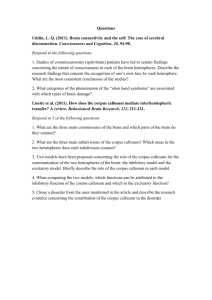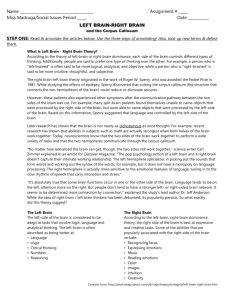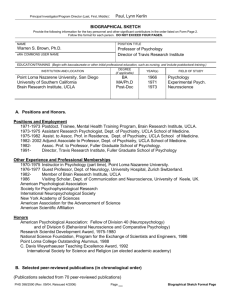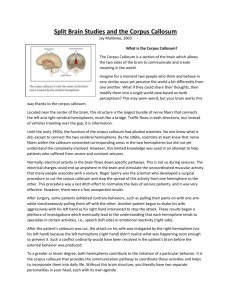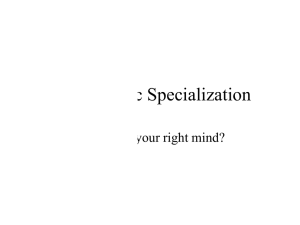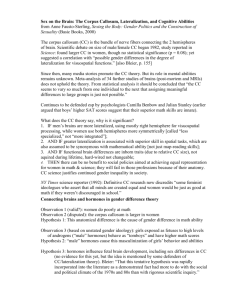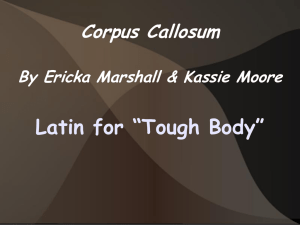Insights into the functional specificity of the human corpus callosum
advertisement
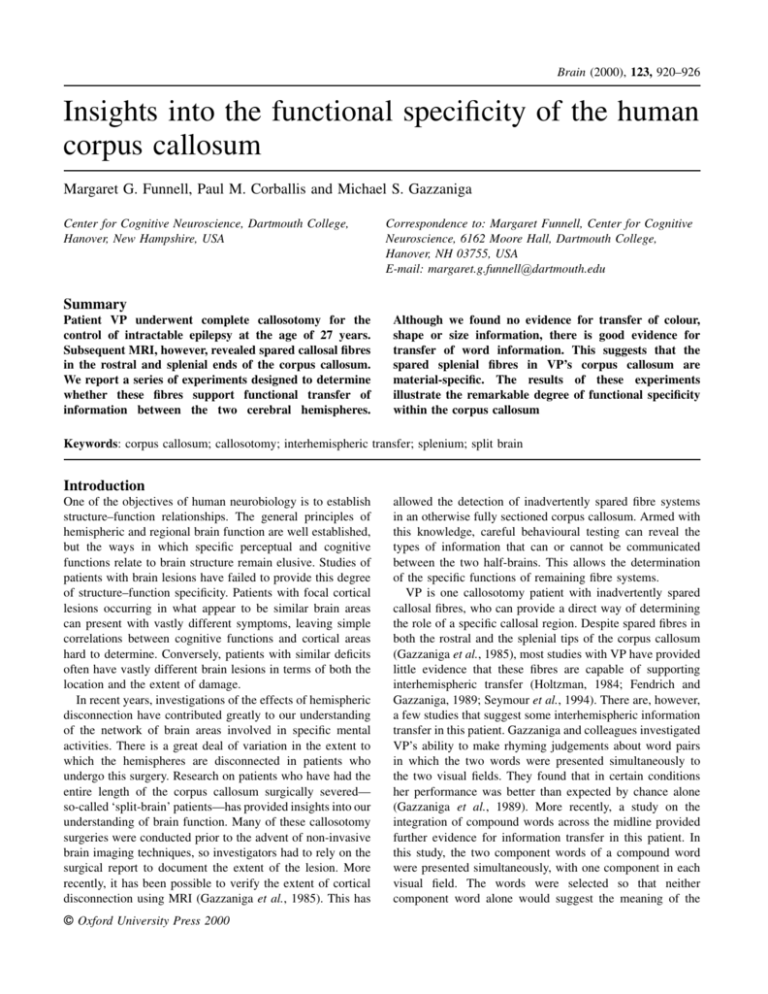
Brain (2000), 123, 920–926 Insights into the functional specificity of the human corpus callosum Margaret G. Funnell, Paul M. Corballis and Michael S. Gazzaniga Center for Cognitive Neuroscience, Dartmouth College, Hanover, New Hampshire, USA Correspondence to: Margaret Funnell, Center for Cognitive Neuroscience, 6162 Moore Hall, Dartmouth College, Hanover, NH 03755, USA E-mail: margaret.g.funnell@dartmouth.edu Summary Patient VP underwent complete callosotomy for the control of intractable epilepsy at the age of 27 years. Subsequent MRI, however, revealed spared callosal fibres in the rostral and splenial ends of the corpus callosum. We report a series of experiments designed to determine whether these fibres support functional transfer of information between the two cerebral hemispheres. Although we found no evidence for transfer of colour, shape or size information, there is good evidence for transfer of word information. This suggests that the spared splenial fibres in VP’s corpus callosum are material-specific. The results of these experiments illustrate the remarkable degree of functional specificity within the corpus callosum Keywords: corpus callosum; callosotomy; interhemispheric transfer; splenium; split brain Introduction One of the objectives of human neurobiology is to establish structure–function relationships. The general principles of hemispheric and regional brain function are well established, but the ways in which specific perceptual and cognitive functions relate to brain structure remain elusive. Studies of patients with brain lesions have failed to provide this degree of structure–function specificity. Patients with focal cortical lesions occurring in what appear to be similar brain areas can present with vastly different symptoms, leaving simple correlations between cognitive functions and cortical areas hard to determine. Conversely, patients with similar deficits often have vastly different brain lesions in terms of both the location and the extent of damage. In recent years, investigations of the effects of hemispheric disconnection have contributed greatly to our understanding of the network of brain areas involved in specific mental activities. There is a great deal of variation in the extent to which the hemispheres are disconnected in patients who undergo this surgery. Research on patients who have had the entire length of the corpus callosum surgically severed— so-called ‘split-brain’ patients—has provided insights into our understanding of brain function. Many of these callosotomy surgeries were conducted prior to the advent of non-invasive brain imaging techniques, so investigators had to rely on the surgical report to document the extent of the lesion. More recently, it has been possible to verify the extent of cortical disconnection using MRI (Gazzaniga et al., 1985). This has © Oxford University Press 2000 allowed the detection of inadvertently spared fibre systems in an otherwise fully sectioned corpus callosum. Armed with this knowledge, careful behavioural testing can reveal the types of information that can or cannot be communicated between the two half-brains. This allows the determination of the specific functions of remaining fibre systems. VP is one callosotomy patient with inadvertently spared callosal fibres, who can provide a direct way of determining the role of a specific callosal region. Despite spared fibres in both the rostral and the splenial tips of the corpus callosum (Gazzaniga et al., 1985), most studies with VP have provided little evidence that these fibres are capable of supporting interhemispheric transfer (Holtzman, 1984; Fendrich and Gazzaniga, 1989; Seymour et al., 1994). There are, however, a few studies that suggest some interhemispheric information transfer in this patient. Gazzaniga and colleagues investigated VP’s ability to make rhyming judgements about word pairs in which the two words were presented simultaneously to the two visual fields. They found that in certain conditions her performance was better than expected by chance alone (Gazzaniga et al., 1989). More recently, a study on the integration of compound words across the midline provided further evidence for information transfer in this patient. In this study, the two component words of a compound word were presented simultaneously, with one component in each visual field. The words were selected so that neither component word alone would suggest the meaning of the Functional specificity of the corpus callosum compound (e.g. breakfast, headstone). The patient was asked to depict the compound word by drawing. In a previous study, Kingstone and Gazzaniga tested patient JW using this paradigm (Kingstone and Gazzaniga, 1995). This patient had a complete callosotomy, which was confirmed by MRI. His drawings always depicted only one of the components and never the compound word. When patient VP was tested, however, she was able to draw the compound on every trial (Funnell et al., 2000). This is evidence that she was able to integrate the two component words to extract the meaning of the compound. This integration is thought to have occurred via her spared callosal fibres, since testing with JW suggests that subcortical pathways are not sufficient for this type of transfer. The regions of spared fibres in VP are circumscribed and well defined, providing an opportunity to investigate the role of these fibre regions in the transfer of information between the two hemispheres. The results of previous experiments with this patient demonstrate that there is some functional interhemispheric transfer, but that this transfer is not seen in some paradigms and with some types of visual information. The purpose of the experiments reported here was to investigate systematically the types of visual information that could be transferred via VP’s spared splenial fibres. It was expected that this would provide direct evidence about the functional specificity of this region of the corpus callosum. Methods Subject Patient VP is a 47-year-old woman who underwent a twostage callosotomy in 1979 at the age of 27 years. Although the callosotomy was reported to be complete, follow-up MRI in 1984 revealed spared fibres in the rostrum and splenium (Gazzaniga et al., 1985) (Fig. 1). The spared rostral fibres comprised ~1.8% of the total cross-sectional area of the corpus callosum and the spared splenial fibres comprised ~1% of the area. VP’s postsurgery intelligence and memory quotients were within normal limits (Gazzaniga et al., 1984). This patient has been tested extensively and information on her medical history and cognitive abilities has been published elsewhere (Sidtis et al., 1981; Gazzaniga et al., 1984). The experimental protocol was approved by the Dartmouth College Committee for the Protection of Human Subjects and written informed consent was obtained from VP. Equipment and procedure In all four experiments, VP was seated ~57 cm from the screen of a Power Macintosh G3 personal computer with a 17-inch colour monitor. She was told to fixate on a central cross-hair, and stimuli were presented for 150 ms. Each stimulus item or pair was presented such that the medial edge of the stimulus was positioned 2–5° from the central cross-hair to ensure that the ipsilateral hemisphere did not 921 Fig. 1 Midsagittal section from VP’s structural MRI showing sparing in the rostral and splenial ends of the corpus callosum. have access to the stimulus. Specific details about the procedure and response mode are included in each experiment. Experiment 1: perceptual matching The first experiment was designed to assess VP’s ability to make between-field perceptual judgements about simultaneously presented pairs of stimuli. Judgements were based on differences in colour, shape or size. To rule out different degrees of interhemispheric transfer in different regions of the visual field, the location of the stimulus pairs varied across the two visual fields. Stimuli Colour The stimuli consisted of 1.5° diameter circles that were red, green or blue. The photopic luminances of the colours were 11.35 cd/m2 for red, 25.63 cd/m2 for green and 7.87 cd/m2 for blue. The luminance of the white background was 37.12 cd/m2. The circles were paired across the midline such that one circle appeared in one visual field and the other circle appeared in the opposite visual field. This resulted in three ‘same’ pairs (e.g. red paired with red) and six ‘different’ pairs (e.g. red paired with blue). Each of the same pairs appeared twice to match the total number of different pairs. The resulting 12 pairs appeared in four horizontal positions with respect to the midline: stimuli were centred 2.5°, 3.75°, 5° and 6.25° from the cross-hair. This resulted in 48 stimulus pairs. In addition, the positions of the pairs also varied along the vertical dimension: stimuli centred 5° above the midline, 2.5° above the midline, at the midline, 2.5° below the midline 922 M. G. Funnell et al. Table 1 Z-scores for each location tested in experiment 1 Vertical distance from midline ⫹5.0° ⫹2.5° 0° –2.5° –5.0° Fig. 2 Schematic diagram of the locations tested in experiment 1. Stimulus pairs were presented with one item in each pair appearing on either side of the vertical midline. The pairs were always shown in corresponding locations. For example, the large circles represent a stimulus pair presented at the horizontal midline, with each item centred 2.5° from the vertical midline. The small circles represent the other possible stimulus locations. and 5° below the midline (Fig. 2). This resulted in a total of 240 stimulus pairs, which were randomly divided into six sets of 40 items. Horizontal distance from midline 2.5° 3.75° 5.0° 6.25° 1.155 1.443 0.000 0.866 0.289 –0.577 1.155 0.289 0.577 0.289 0.000 0.000 0.577 –0.866 0.866 0.577 –1.155 –0.577 0.289 1.732 Horizontal distances refer to the distance in degrees of visual angle of each stimulus from the vertical midline. Vertical distances refer to the distance from the horizontal midline at which the stimulus pair was presented. None of these scores reached significance at the P ⫽ 0.05 level. significantly greater than chance (Table 1). The lack of transfer suggests that neither subcortical pathways nor VP’s spared callosal fibres are sufficient for transfer of colour, size or shape information. Although VP was instructed to maintain fixation on a central cross-hair, her fixation was not monitored during the course of the experiment. The lack of any evidence for interhemispheric transfer provides evidence that VP did maintain fixation. Experiment 2: delayed perceptual matching Size The stimuli consisted of black circles (circle luminance ⫽ 5.57 cd/m2, background luminance ⫽ 37.12 cd/m2) that varied in size: small (visual angle ⫽ 1°), medium (visual angle ⫽ 1.5°) and large (visual angle ⫽ 2°). The stimulus pairs were constructed in the same way as described above and were presented in analogous locations, resulting in six sets of 40 items. Shape The stimuli consisted of black circles, squares and triangles (luminance ⫽ 5.57 cd/m2). Each shape fitted within a 1.5°⫻1.5° area. The stimulus pairs were constructed and presented in the same way as the colour and size pairs. Procedure The testing procedure was the same for all three types of stimuli. VP fixated on a central cross-hair and each stimulus pair was presented for 150 ms. After presentation of each pair, VP verbally responded ‘yes’ if the two items in the pair were identical and ‘no’ if they were not. In simultaneous matching, attentional resources must be divided between the two visual fields, and this may interfere with the ability to make accurate judgements about the stimuli. In order to remove this possible confound, perceptual matching was assessed using a delayed matching procedure. Stimuli Coloured shapes Target items were nine objects that varied in colour (red, blue or green) and shape (circle, square or triangle). Each target item was associated with three response pairs, resulting in a total of 27 response pairs, each of which consisted of two items aligned vertically. One item in each pair matched the corresponding target item, and the other object differed from the target in colour, shape or both (Fig. 3). The target item and the corresponding response pair appeared in different visual fields. For example, if the target item appeared in the right visual field, then the corresponding response item appeared in the left visual field. Each target item/response pair combination appeared twice in each set, resulting in a total of 54 trials. In the second presentation of the trial, the visual fields were reversed so that the target item appeared in the left visual field and the response item in the right. VP completed six sets of the 54 items, which appeared in a different random order in each set. Results and discussion There was no evidence of perceptual transfer for colour, size or shape in any of the 20 locations assessed. Binomial tests revealed no location for which VP’s accuracy was Words The stimuli were identical to those in the previous experiment except that the objects used as target items were replaced Functional specificity of the corpus callosum 923 information, there was evidence for some limited transfer of word information. Experiment 3: rhyming judgements Although the results of the previous experiment provide evidence for the transfer of word information, the nature of this transfer remains unclear. In a subsequent experiment, which was a replication of that of Gazzaniga and colleagues (Gazzaniga et al., 1989), we investigated what aspects of words are transferred between VP’s two hemispheres. Stimuli Fig. 3 Black-and-white schematic diagram of the paradigm for experiment 2. A target stimulus was presented to one visual field and a response pair was presented to the opposite visual field. VP responded by pointing to the location on the screen of the item that matched the target. (A) The condition in which the target was a coloured object. (B) The condition in which the target object was replaced by a verbal description. with verbal descriptions of the item. For example, a picture of a green square was replaced with the words ‘green square.’ The response items were pictures, as in the preceding experiment (Fig. 3). The target words and corresponding response pairs again appeared in different visual fields. Each target item/response pair combination appeared twice in each set, resulting in a total of 54 trials per set. VP completed six randomized orders of these 54 trials. Procedure VP fixated on a central cross-hair. A target item was flashed to one visual field for 150 ms, there was a pause of 150 ms and then a response pair was flashed for 150 ms to the contralateral visual field. After presentation of each response pair, VP pointed to the position on the computer monitor (up or down) of the item that matched the target. She responded with the hand ipsilateral to the response pair. Results and discussion VP was at chance in selecting which of the two items in the response pair matched the target item (correct selection ⫽ 177/324 ⫽ 0.55, binomial test z ⫽ 1.67, n.s.) when the target item was a coloured shape. This is consistent with the results of the previous experiment, indicating that there is no evidence for interhemispheric transfer of colour, size or shape information. For the word targets, VP’s accuracy was low but was significantly better than chance in selecting which of the two items in the response pair matched the target description (correct selection ⫽ 208/324 ⫽ 0.64, binomial test z ⫽ 4.97, P ⬍ 0.01). This suggests that, although there was no evidence for transfer of colour, size or shape The stimuli consisted of four types of word pairs. The first type were pairs of words that looked and sounded like rhymes (e.g. tire and fire). The second type were word pairs that looked as if they should rhyme but did not (e.g. cough and dough). A third category consisted of words that did not look as if they should rhyme but did (e.g. bake and ache). The fourth category were pairs of words that neither looked nor sounded like rhymes (e.g. keys and fort). There were 60 word pairs in each condition, giving a total of 240 pairs. Procedure VP fixated on a central cross-hair and each word pair was presented for 150 ms. The two words in each pair were presented simultaneously, with one word on each side of the cross-hair. The experiment was run twice. The second run was the same as the first except that the visual fields of each word in the pair were reversed (i.e. if a word appeared in the right visual field in the first run, it appeared in the left field in the second run). After presentation of each word pair, VP responded ‘yes’ if the two words in the pair rhymed and ‘no’ if they did not. Results and discussion Because this experiment involved analysis of data collected from a single observer, statistical tests on VP’s responses were carried out using a hierarchical χ2 analysis (Winer et al., 1991). Discrimination accuracy in these analyses is indexed by the interaction between experimental condition and response. Response bias is indexed by the interaction between experimental condition and response. The factorial design of the experiments allows higher-order interaction effects to be evaluated in a manner directly analogous to analysis of variance. VP’s performance was above chance in this task [χ2(1) ⫽ 62.65, P ⬍ 0.01] and she was able to distinguish among the different conditions (Fig. 4). When the word pairs did not sound like rhymes, VP was able to say accurately that the words did not rhyme regardless of whether or not the words looked as if they should rhyme (0.167 for both conditions). When the words did rhyme, VP was more likely to say that they rhymed, particularly if the words also looked 924 M. G. Funnell et al. Fig. 4 Proportion of rhyme judgements for each condition in experiment 3. R–/L– ⫽ words sound and look different; R–/ L⫹ ⫽ words sound different but look similar; R⫹/L– ⫽ words sound similar but look different; R⫹/L⫹ ⫽ words look and sound similar. as if they should rhyme [did not look like rhymes, 0.417; looked like rhymes, 0.6; χ2(1) ⫽ 4.51; P ⬍ 0.05]. This is consistent with her performance in previous testing (Gazzaniga et al., 1989) and suggests that there is some transfer of word information. Experiment 4: secret word paradigm The two previous experiments provided evidence for the interhemispheric transfer of word information. It is unclear from either experiment, however, whether the whole word is transferred from one hemisphere to the other or if only some aspects (such as phonology) are transferred. A paradigm previously introduced by Gazzaniga and colleagues (Gazzaniga et al., 1982) was adapted to address this issue. Stimuli Stimuli consisted of 16 lists of 10 words. Prior to each test set, two words were presented to the same visual field. The first word was designated the ‘secret’ word and the second word the ‘substitute’ word. The secret word then appeared once in each visual field in the subsequent list of 10 words. In all test lists, the secret word first appeared in the visual field contralateral to its initial presentation. The position of the secret words in the test list was determined randomly. Procedure At the start of each test set, VP was shown two successive words to the same visual field. When the first of the words appeared, she was told that the word was the secret word and she should not say the word aloud. When the second word (the substitute word) was presented, she was told that whenever she saw the secret word she should say the substitute word instead. For example, if the first two words were ‘sofa’ and ‘book’, VP was to say ‘book’ every time the word ‘sofa’ appeared on the screen. During the presentation of the secret word and the substitute word, neither word was said aloud. After the presentation of the secret word and the Fig. 5 Schematic diagram of the paradigm for experiment 4. Prior to each test set, two words were presented to the same visual field (A). The first word was the ‘secret’ word and the second word was the ‘substitute’ word. VP was instructed that whenever the secret word appeared in the test list (B), she should say the substitute word instead. substitute word, the test list was initiated (Fig. 5). VP was told to fixate on a central cross-hair and say the word that was presented. After each response, the next trial was initiated by the experimenter. Results and discussion The secret and substitute words were presented to the same visual field. Therefore, one hemisphere had specific information about these words but the other hemisphere was given no information. In the test lists, the secret word appeared first in the contralateral field so there was no opportunity for cross-hemispheric cueing to have occurred. In the absence of any interhemispheric information transfer, the probability of producing the correct substitute word when shown the secret word in the contralateral visual field is essentially zero. Remarkably, VP was able to produce the substitute word eight out of 16 times in this condition. In an additional four instances, VP indicated knowledge of the secret word although she was not able to produce the correct substitute word. She expressed this knowledge by raising her hand and hesitating, then producing a previous substitute word or producing an incorrect substitute word. This is strong evidence that there is information transfer between hemispheres. There was no evidence that transfer occurred more readily in one direction than in the other. General discussion Although VP showed no evidence for transfer of colour, size or shape, there was compelling evidence for transfer of word information. Previous research has demonstrated that word information is not transferred subcortically (e.g. Gazzaniga et al., 1984; Kingstone and Gazzaniga, 1995), suggesting Functional specificity of the corpus callosum that the transfer in patient VP is occurring via her spared callosal fibres. The finding that there is transfer of some types of visual information (words) but not others (colour, shape, size) provides insight into the remarkable specificity of callosal fibres. Post-mortem research on human and monkey brains has revealed that the corpus callosum is topographically organized, with anterior fibres connecting the frontal regions of the two hemispheres and posterior fibres connecting the posterior cortical structures. Specifically, fibres from the superior parietal lobule and the occipital cortex pass exclusively through the splenium, whereas frontal fibres pass through the rostral half of the corpus callosum, including the genu. This anterior-to-posterior organization results in modality-specific regions of the corpus callosum (Pandya et al., 1971; de Lacoste et al., 1985). Research has revealed that the anterior midbody transfers motor information, the posterior midbody transfers somatosensory information, the isthmus transfers auditory information and the splenium transfers visual information. For example, Risse and colleagues reported that lesions of the anterior two-thirds of the corpus callosum that spared the splenium resulted in disruption of interhemispheric transfer in a dichotic listening task and some somatosensory tasks (Risse et al., 1989). Patients who underwent more complete anterior callosal sectioning that spared only one-third of the splenium demonstrated intact visual transfer but a lack of interhemispheric transfer in all other modalities. Lesions restricted to the posterior corpus callosum disrupted interhemispheric visual transfer but other modalities were unaffected (Gazzaniga and Freedman, 1973). VP’s spared callosal fibres are in the rostrum and splenium. The rostrum connects frontal brain regions and is unlikely to be involved in the transfer of visual information. Since the splenial region of the corpus callosum is known to connect occipital brain regions (Clarke and Miklossy, 1990), it is likely that VP’s interhemispheric transfer of word information is occurring via her spared splenial fibres. Her callosotomy surgery was performed in two stages. The anterior portion was sectioned first, followed 7 weeks later by the posterior section (Sidtis et al., 1981). The anterior and posterior sections were both performed from a central craniotomy. The spared fibres are therefore likely to be those most distal from the point of surgical entry. Because of the shape of the corpus callosum, this would result in sparing of fibres in the ventral parts of the corpus callosum. In the anterior section the sparing would probably include the most rostral fibres, and in the posterior section it would be the fibres in the ventroposterior region of the splenium. The results of the reported experiments with patient VP are consistent with recent speculations of Suzuki and colleagues (Suzuki et al., 1998). They describe a patient with a lesion limited to the ventroposterior end of the splenium who was able to transfer picture information but not letter information. After reviewing the literature on patients with splenial lesions, Suzuki and colleagues concluded that the anterior to middle 925 portion of the splenium is involved in transfer of picture information and the ventroposterior portion is involved in transfer of letter information (Suzuki et al., 1998). The importance of the posterior corpus callosum for the transfer of visually presented words has long been recognized. For example, Dejerine reported a patient with pure alexia (alexia without agraphia) who had damage to the left occipital lobe and the splenium of the corpus callosum (Dejerine, 1891). This patient was evidently unable to read because words presented to the right of fixation fell within the blind visual field and words presented to the left of fixation could not be transferred to the left hemisphere through the splenium (Geschwind, 1972). It is important to note that pure alexia is a specific reading deficit—patients are typically able to recognize and name objects presented visually. Lesions that disconnect the left angular gyrus from visual inputs are often associated with pure alexia (Damasio and Damasio, 1983). A variety of imaging studies have suggested the existence of a visual word area in the lateral occipital lobe (Petersen et al., 1988; Uchida et al., 1999). Although the precise location of this area is unclear and perhaps somewhat variable (Fiez and Petersen, 1998), it is likely that splenial fibres connect the visual word form area to homologous regions in the contralateral hemisphere. Investigations with patient VP suggest that her spared splenial fibres terminate in the visual word form area and are responsible for the transfer of words. These fibres do not, however, support the transfer of nonword visual information such as colour and size. Although the data clearly indicate that VP’s spared splenial fibres are capable of transferring words between the two hemispheres, the nature of this transfer is unclear. The individual letters of each word could be transferred from one hemisphere to the other and then each hemisphere could construct the resulting word from the letters. The two hemispheres have different approaches to letter strings and this might affect the efficiency of transfer in one direction or the other. The right hemisphere appears to use a serial processing approach, whereas the left uses parallel processing (Reuter-Lorenz and Baynes, 1992). This might imply that the right hemisphere uses a letter-by-letter approach to reading words whereas the left hemisphere is also capable of reading whole words. An alternative to the transfer of individual letters could be that the hemisphere that ‘sees’ the letters constructs the word and then transfers the whole word to the other hemisphere. This whole-word transfer might or might not include phonological and semantic information. The results of the study with rhyming words (Gazzaniga et al., 1989) suggest that there is some transfer of phonological information via VP’s spared fibres. In summary, the data suggest that VP’s spared splenial fibres are capable of transferring word information but not other visual information. We conclude that there is a remarkable degree of specificity within the corpus callosum and that investigations with callosotomy patients who have spared callosal fibres can reveal this functional topography. 926 M. G. Funnell et al. Acknowledgements We thank patient VP and her family for their willing participation in this research. This work was supported by grants from NIH/NINDS and by a grant from the McDonnellPew Foundation. References Clarke S, Miklossy J. Occipital cortex in man: organization of callosal connections, related myelo- and cytoarchitecture, and putative boundaries of functional visual areas. J Comp Neurol 1990; 298: 188–214. Damasio AR, Damasio H. The anatomic basis of pure alexia. Neurology 1983; 33: 1573–83. Gazzaniga MS, Kutas M, Van Petten C, Fendrich R. Human callosal function: MRI-verified neuropsychological functions. Neurology 1989; 39: 942–6. Geschwind N. Language and the brain. Sci Am 1972; 226: 76–83. Holtzman JD. Interactions between cortical and subcortical visual areas: evidence from human commissurotomy patients. Vision Res 1984; 24: 801–13. Kingstone A, Gazzaniga MS. Subcortical transfer of higher order information: more illusory than real? Neuropsychology 1995; 9: 1763–6. Pandya DN, Karol EA, Heilbronn D. The topographical distribution of interhemispheric projections in the corpus callosum of the rhesus monkey. Brain Res 1971; 32: 31–43. Dejerine J. Sur un cas de cécité verbale avec agraphia, suivi d’autopsie. C R Seanc Soc Biol 1891; 3: 197–201. Petersen SE, Fox PT, Posner MI, Mintun M, Raichle ME. Positron emission tomographic studies of the cortical anatomy of singleword processing. Nature 1988; 331: 585–9. De Lacoste MC, Kirkpatrick JB, Ross ED. Topography of the human corpus callosum. J Neuropathol Exp Neurol 1985; 44: 578–91. Reuter-Lorenz PA, Baynes K. Modes of lexical access in the callosotomized brain. J Cogn Neurosci 1992; 4: 155–64. Fendrich R, Gazzaniga MS. Evidence of foveal splitting in a commissurotomy patient. Neuropsychologia 1989; 27: 273–81. Risse GL, Gates J, Lund G, Maxwell R, Rubens A. Interhemispheric transfer in patients with incomplete section of the corpus callosum: anatomic verification with magnetic resonance imaging. Arch Neurol 1989; 46: 437–43. Fiez JA, Petersen SE. Neuroimaging studies of word reading. [Review]. Proc Natl Acad Sci USA 1998; 95: 914–21. Funnell MG, Corballis PM, Gazzaniga MS. Cortical and subcortical interhemispheric interactions following partial and complete callosotomy. Arch Neurol. In press 2000. Seymour SE, Reuter-Lorenz PA, Gazzaniga MS. The disconnection syndrome: basic findings reaffirmed. Brain 1994; 117: 105–15. Gazzaniga MS, Freedman H. Observations on visual processes after posterior callosal section. Neurology 1973; 23: 1126–30. Sidtis JJ, Volpe BT, Wilson DH, Rayport M, Gazzaniga MS. Variability in right hemisphere language function after callosal section: evidence for a continuum of generative capacity. J Neurosci 1981; 1: 323–31. Gazzaniga MS, Sidtis JJ, Volpe BT, Smylie C, Holtzman J, Wilson D. Evidence for paracallosal verbal transfer after callosal section. Brain 1982; 105: 53–63. Suzuki K, Yamadori A, Endo K, Fujii T, Ezura M, Takahashi A. Dissociation of letter and picture naming resulting from callosal disconnection. [Review]. Neurology 1998; 51: 1390–4. Gazzaniga MS, Nass R, Reeves A, Roberts D. Neurologic perspectives on right hemisphere language following surgical section of the corpus callosum. Semin Neurol 1984a; 4: 126–35. Uchida I, Kikyo H, Nakajima K, Konishi S, Sekihara K, Miyashita Y. Activation of lateral extrastriate areas during orthographic processing of Japanese characters studied with fMRI. Neuroimage 1999; 9: 208–15. Gazzaniga MS, Smylie CS, Baynes K, Hirst W, McCleary C. Profiles of right hemisphere language and speech following brain bisection. Brain Lang 1984b; 22: 206–20. Winer BJ, Brown DR, Michels KM. Statistical principles in experimental design. 3rd ed. New York: McGraw-Hill; 1991. Gazzaniga MS, Holtzman JD, Deck MD, Lee BC. MRI assessment of human callosal surgery with neuropsychological correlates. Neurology 1985; 35: 1763–66. Received July 30, 1999. Revised November 15, 1999. Accepted November 15, 1999
